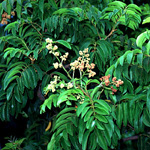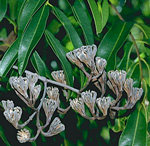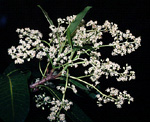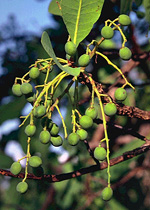 |
A medium-sized family, most Anacardiaceae are found in warm parts of the world, with some extension into temperate and cold regions of the Northern Hemisphere. Native species in Australia are restricted to rainforests and monsoon forests and woodlands in northern Australia, from the Kimberley region of Western Australia, across the Top End of the Northern Territory to coastal Queensland and northern New South Wales. The introduced peppercorn tree (Schinus molle) has been widely planted and is occasionally naturalised in southern, usually inland, Australia, while the mango (Mangifera indica) is almost ubiquitous near homesteads and settlements in northern Australia.
Characteristic features of the family Anacardiaceae in Australia include: - trees or shrubs, usually with an aromatic smell to leaves and twigs; some species cause serious allergic responses in many people (test not recommended!)
- leaves usually pinnate
- flowers small, regular, 5-partite, in much-branched panicles
- stamens 5,10 or more, situated outside a prominent fleshy disc
- ovary superior, developing into a large, often hard, drupe
Description
Evergreen or semi-deciduous trees or shrubs. Internal secretions of allergenic or poisonous resin or sometimes with milky sap (latex). Plants glabrous or with simple, non-glandular, uniseriate hairs. Leaves alternate and spiral, opposite or apparently whorled, petiolate; pulvinae present or absent. Stipules and stipellae absent. Lamina simple or once compound, paripinnate or imparipinnate, symmetric or conspicuously asymmetric, dorsiventral; lamina or leaflets lanceolate, ovate, elliptic, oblanceolate, obovate or oblong; base cuneate, attenuate or oblique; margins entire or sinuate, ±flat; venation pinnate, with the midrib conspicuous, and the tertiary venation reticulate; surfaces not punctate; herbaceous or leathery; distinctive odour absent, aromatic or resinous. Domatia absent or consisting of pits, pockets or hair tufts in the vein angles. Male and female flowers occurring on separate plants, or bisexual flowers and male and female flowers occurring on the same plant, or bisexual flowers and male flowers on some plants and bisexual flowers and female flowers on others, or with all the flowers bisexual. Inflorescences terminal or axillary, consisting of glomerules, panicles or cymes. Bracts and bracteoles present. Flowers sessile or stalked. Floral disc present; nectaries present on the disc. Perianth regular, of 2 dissimilar whorls, imbricate in bud. Calyx segments fused, with (4) 5 (6) lobes; calyx cup-shaped, herbaceous. Corolla segments free, with (4) 5 (6) petals, alternating with the calyx lobes, imbricate or valvate in bud; corolla white, cream, red or pink, without contrasting markings, membranous or papery; lobes ±entire; Fertile stamens (1) 5 (610 or more), opposite to the calyx lobes, free of the corolla, free of the ovary and style, distinct from each other, all ±equal. Staminodes present. Anthers dorsifixed or basifixed, versatile or not versatile, opening inwards by longitudinal slits; 2-celled. Ovary superior and sessile. Carpels 13 (12), fused; ovary with 1–12 locules. Style gynobasic, terminal or eccentric, single and unbranched or branched above or from the base. Ovules 1 per locule, stalked; placentation basal, apical or axile. Fruit a dry indehiscent nut or fleshy drupe; the perianth on the maturing fruit deciduous, dry and persistent or growing larger. Disseminule macro-surface featureless or with straight hairs; micro-surface ±smooth, yellow, orange, pink, brown or black, glossy or dull. Seeds 1–12 per fruit. Aril absent. Cotyledons 2. Embryo straight or curved.
(Note: this description has been generated from the coded data compiled for the key. Any errors in the key data will be reflected in the descriptions.)
A treatment of the family Anacardiaceae has been published in:
Flora of Australia 25: 170-187.
Australian genera of Anacardiaceae (as recognised for the Flora of Australia)
* = all species introduced
Blepharocarya
Buchanania
Euroschinus
*Mangifera
Pleiogynium
Rhodosphaera
*Rhus
*Schinus
Semecarpus

|
  |

Blepharocarya involucrigera (flowering branch)
Photo: G.Sankowski © Zodiac Publications

Blepharocarya involucrigera (fruits)
Photo: H.Nicholson © H. & N. Nicholson

Buchanania arborescens (flowers)
Photo: G.Sankowski © Zodiac Publications

Buchanania obovata (fruits)
Photo: D.Jones © D.Jones

|
 |
|